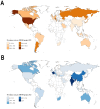Updated Trends in Valvular Heart Disease-Related Heart Failure in G20-the Group of Twenty Countries: Insights From the Global Burden of Disease Study 2021
- PMID: 40927079
- PMCID: PMC12415752
- DOI: 10.31083/RCM38912
Updated Trends in Valvular Heart Disease-Related Heart Failure in G20-the Group of Twenty Countries: Insights From the Global Burden of Disease Study 2021
Abstract
Background: Valvular heart disease (VHD), including both non-rheumatic valvular heart disease (NRVHD) and rheumatic valvular heart disease (RVHD), is a major global health concern. Moreover, the progression of VHD to heart failure (HF) poses substantial clinical and public health challenges. In light of the global population aging, alongside increasing cardiovascular risk factors, and the additional strain imposed by the COVID-19 pandemic, a timely reassessment of the VHD-related HF burden is urgently needed. Using the most recent data from the Global Burden of Disease (GBD) Study 2021, this study aimed to evaluate the distribution of VHD-related HF burden in 2021, examining the long-term trends from 1990 to 2021, and short-term changes between 2019 and 2021, to provide updated insights to inform future prevention and management strategies.
Methods: Using GBD 2021 data, we analyzed the distribution of VHD-related HF burden in age-standardized prevalence rates across the Group of Twenty (G20) countries.
Results: The highest NRVHD-related HF burden in 2021 was observed in the United States (US), Italy, and Russia, while the highest RVHD-related HF burden was noted in India, France, and China. Over the past 30 years (1990-2021), the NRVHD-related HF burden decreased in developed countries (e.g., the US, Canada, Japan) but increased in emerging economies (e.g., India, Brazil, South Africa), with significant increases also observed in Argentina, Mexico, Brazil, among other countries. Notably, nearly all G20 countries exhibited a downward trend in RVHD-related HF burden, with Germany and Australia being the exceptions. During the COVID-19 pandemic (2019-2021), the NRVHD-related HF burden declined in most G20 nations, except for South Africa, India, and a few others, while the RVHD-related HF burden increased slightly in countries such as Mexico, Russia, and Indonesia.
Conclusions: Trends in NRVHD- and RVHD-related HF burden across G20 countries exhibited notable variations, and these became more pronounced under the impact of the COVID-19 pandemic. These findings underscore the importance of developing long-term strategies to enhance the resilience of healthcare systems, improve chronic disease management, and optimize resource allocation to promote cardiovascular health and preparedness for public health challenges.
Keywords: Group of 20; disease burden; heart failure; valvular heart disease.
Copyright: © 2025 The Author(s). Published by IMR Press.
Conflict of interest statement
The authors declare no conflict of interest.
Figures


References
-
- Zhang S, Liu C, Wu P, Li H, Zhang Y, Feng K, et al. Burden and Temporal Trends of Valvular Heart Disease-Related Heart Failure From 1990 to 2019 and Projection Up to 2030 in Group of 20 Countries: An Analysis for the Global Burden of Disease Study 2019. Journal of the American Heart Association . 2024;13:e036462. doi: 10.1161/JAHA.124.036462. - DOI - PMC - PubMed
-
- Ojha U, Marshall DC, Salciccioli JD, Al-Khayatt BM, Hammond-Haley M, Goodall R, et al. Temporal trend analysis of rheumatic heart disease burden in high-income countries between 1990 and 2019. European Heart Journal. Quality of Care & Clinical Outcomes . 2024;10:108–120. doi: 10.1093/ehjqcco/qcac083. - DOI - PMC - PubMed
LinkOut - more resources
Full Text Sources
Research Materials
Miscellaneous

